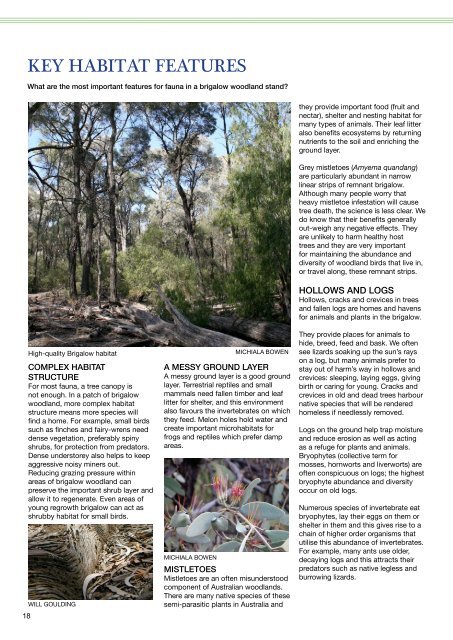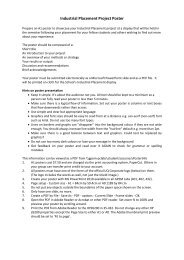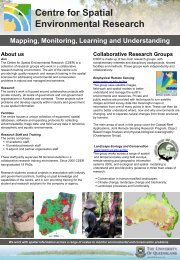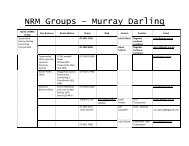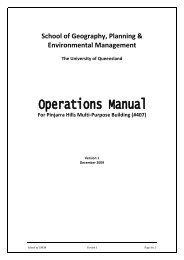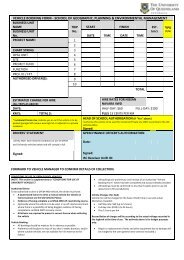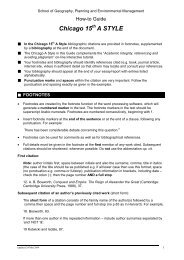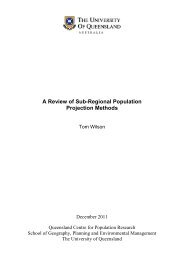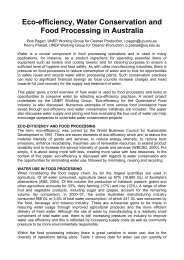Conserving Biodiversity in Brigalow Regrowth - School of ...
Conserving Biodiversity in Brigalow Regrowth - School of ...
Conserving Biodiversity in Brigalow Regrowth - School of ...
You also want an ePaper? Increase the reach of your titles
YUMPU automatically turns print PDFs into web optimized ePapers that Google loves.
Key habitat features<br />
What are the most important features for fauna <strong>in</strong> a brigalow woodland stand?<br />
18<br />
High-quality <strong>Brigalow</strong> habitat<br />
complex habitat<br />
structure<br />
For most fauna, a tree canopy is<br />
not enough. In a patch <strong>of</strong> brigalow<br />
woodland, more complex habitat<br />
structure means more species will<br />
f<strong>in</strong>d a home. For example, small birds<br />
such as f<strong>in</strong>ches and fairy-wrens need<br />
dense vegetation, preferably sp<strong>in</strong>y<br />
shrubs, for protection from predators.<br />
Dense understorey also helps to keep<br />
aggressive noisy m<strong>in</strong>ers out.<br />
Reduc<strong>in</strong>g graz<strong>in</strong>g pressure with<strong>in</strong><br />
areas <strong>of</strong> brigalow woodland can<br />
preserve the important shrub layer and<br />
allow it to regenerate. Even areas <strong>of</strong><br />
young regrowth brigalow can act as<br />
shrubby habitat for small birds.<br />
WILL GOULDING<br />
MICHIALA BOWEN<br />
a messy ground layer<br />
A messy ground layer is a good ground<br />
layer. Terrestrial reptiles and small<br />
mammals need fallen timber and leaf<br />
litter for shelter, and this environment<br />
also favours the <strong>in</strong>vertebrates on which<br />
they feed. Melon holes hold water and<br />
create important microhabitats for<br />
frogs and reptiles which prefer damp<br />
areas.<br />
MICHIALA BOWEN<br />
Mistletoes<br />
Mistletoes are an <strong>of</strong>ten misunderstood<br />
component <strong>of</strong> Australian woodlands.<br />
There are many native species <strong>of</strong> these<br />
semi-parasitic plants <strong>in</strong> Australia and<br />
they provide important food (fruit and<br />
nectar), shelter and nest<strong>in</strong>g habitat for<br />
many types <strong>of</strong> animals. Their leaf litter<br />
also benefits ecosystems by return<strong>in</strong>g<br />
nutrients to the soil and enrich<strong>in</strong>g the<br />
ground layer.<br />
Grey mistletoes (Amyema quandang)<br />
are particularly abundant <strong>in</strong> narrow<br />
l<strong>in</strong>ear strips <strong>of</strong> remnant brigalow.<br />
Although many people worry that<br />
heavy mistletoe <strong>in</strong>festation will cause<br />
tree death, the science is less clear. We<br />
do know that their benefits generally<br />
out-weigh any negative effects. They<br />
are unlikely to harm healthy host<br />
trees and they are very important<br />
for ma<strong>in</strong>ta<strong>in</strong><strong>in</strong>g the abundance and<br />
diversity <strong>of</strong> woodland birds that live <strong>in</strong>,<br />
or travel along, these remnant strips.<br />
Hollows and logs<br />
Hollows, cracks and crevices <strong>in</strong> trees<br />
and fallen logs are homes and havens<br />
for animals and plants <strong>in</strong> the brigalow.<br />
They provide places for animals to<br />
hide, breed, feed and bask. We <strong>of</strong>ten<br />
see lizards soak<strong>in</strong>g up the sun’s rays<br />
on a log, but many animals prefer to<br />
stay out <strong>of</strong> harm’s way <strong>in</strong> hollows and<br />
crevices: sleep<strong>in</strong>g, lay<strong>in</strong>g eggs, giv<strong>in</strong>g<br />
birth or car<strong>in</strong>g for young. Cracks and<br />
crevices <strong>in</strong> old and dead trees harbour<br />
native species that will be rendered<br />
homeless if needlessly removed.<br />
Logs on the ground help trap moisture<br />
and reduce erosion as well as act<strong>in</strong>g<br />
as a refuge for plants and animals.<br />
Bryophytes (collective term for<br />
mosses, hornworts and liverworts) are<br />
<strong>of</strong>ten conspicuous on logs; the highest<br />
bryophyte abundance and diversity<br />
occur on old logs.<br />
Numerous species <strong>of</strong> <strong>in</strong>vertebrate eat<br />
bryophytes, lay their eggs on them or<br />
shelter <strong>in</strong> them and this gives rise to a<br />
cha<strong>in</strong> <strong>of</strong> higher order organisms that<br />
utilise this abundance <strong>of</strong> <strong>in</strong>vertebrates.<br />
For example, many ants use older,<br />
decay<strong>in</strong>g logs and this attracts their<br />
predators such as native legless and<br />
burrow<strong>in</strong>g lizards.


